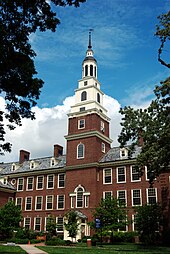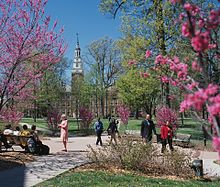Berea College
It incorporates a mandatory work-study program that requires students to engage in a minimum of 10 hours per week of work for the college.
[10] The college began as a one-room schoolhouse that also served as a church on Sundays on land that was granted to Fee by politician and abolitionist Cassius Marcellus Clay.
Although the school's first articles of incorporation were adopted in 1859, founder John Gregg Fee and the teachers were forced out of the area by pro-slavery supporters in that same year.
Fee spent the Civil War years raising funds for the school, trying to provide for his family in Cincinnati, Ohio, and working at Camp Nelson.
He spent nearly 18 months working mostly at Camp Nelson, where he helped provide facilities for the freedmen and their families, as well as teaching and preaching.
When the challenge failed, the college had to become a segregated all-white school, but it raised funds to establish the Lincoln Institute in 1912 in Simpsonville, Kentucky, to educate Black students.
In 1925, famed advertiser Bruce Barton, a future congressman, sent a letter to 24 wealthy men in America to raise funds for the college.
[18] Berea students are also eligible to win the Thomas J. Watson Fellowship, which provides funding for a year of study abroad following graduation.
[26] The 2025 annual ranking of U.S. News & World Report categorizes Berea as 'more selective' and rates it 40th overall, first in "Service Learning," second for "Most Innovative Schools," tied for 9th in "Best Undergraduate Teaching" and fifth in "Top Performers in Social Mobility" among liberal arts colleges in the U.S.[27][28] Kiplinger's Personal Finance places Berea 35th in its 2019 ranking of 149 best value liberal arts colleges in the United States.
Admission to the college is granted only to students who need financial assistance (as determined by the FAFSA); in general, applications are accepted only from those whose family income falls within the bottom 40% of U.S. households.
About 75% of the college's incoming class is drawn from the Appalachian region of the South and some adjoining areas, and about 8% are international students.
[37] As of 2022, students are paid an hourly wage from $5.60 to $8.60 by the college, based on the WLS ("Work, Learning, and Service") level attached to individual labor positions.
[38] The college regularly increases student pay on a yearly basis, but it has never been equivalent to the federal minimum wage in the school's history.
In an effort to be sensitive to the diverse preferences and experiences of students and faculty, these courses are designed to be taught with respect for the unique spiritual journey of each individual, regardless of religious identification.
The Hutchins Library maintains an extensive collection of books, archives, and music pertaining to the history and culture of the Southern Appalachian region.
Students take off from classes for a sunrise hike to the top of the Pinnacle Mountain and engage in games, performances, food, and other festivities.
[39] Another unique holiday to Berea College is Labor Day, where the campus takes a break from classes to recognize and celebrate the value of student work.
Established in 1921, it has expanded to help students find labor placements for the following academic year and soon-to-be graduates prepare for life after college.
[41] On February 20, 2012, the NCAA announced it had granted Berea permission to begin a one-year period exploring membership in its Division III, non-scholarship athletic program.
[44] On June 1, 2023, Berea and the Heartland Collegiate Athletic Conference announced that the Mountaineers would join that league after the 2023–24 school year.
[45] On February 4, 1954, Irvine Shanks was in the lineup for Berea against Ohio Wilmington, breaking the color barrier in college basketball in Kentucky.


